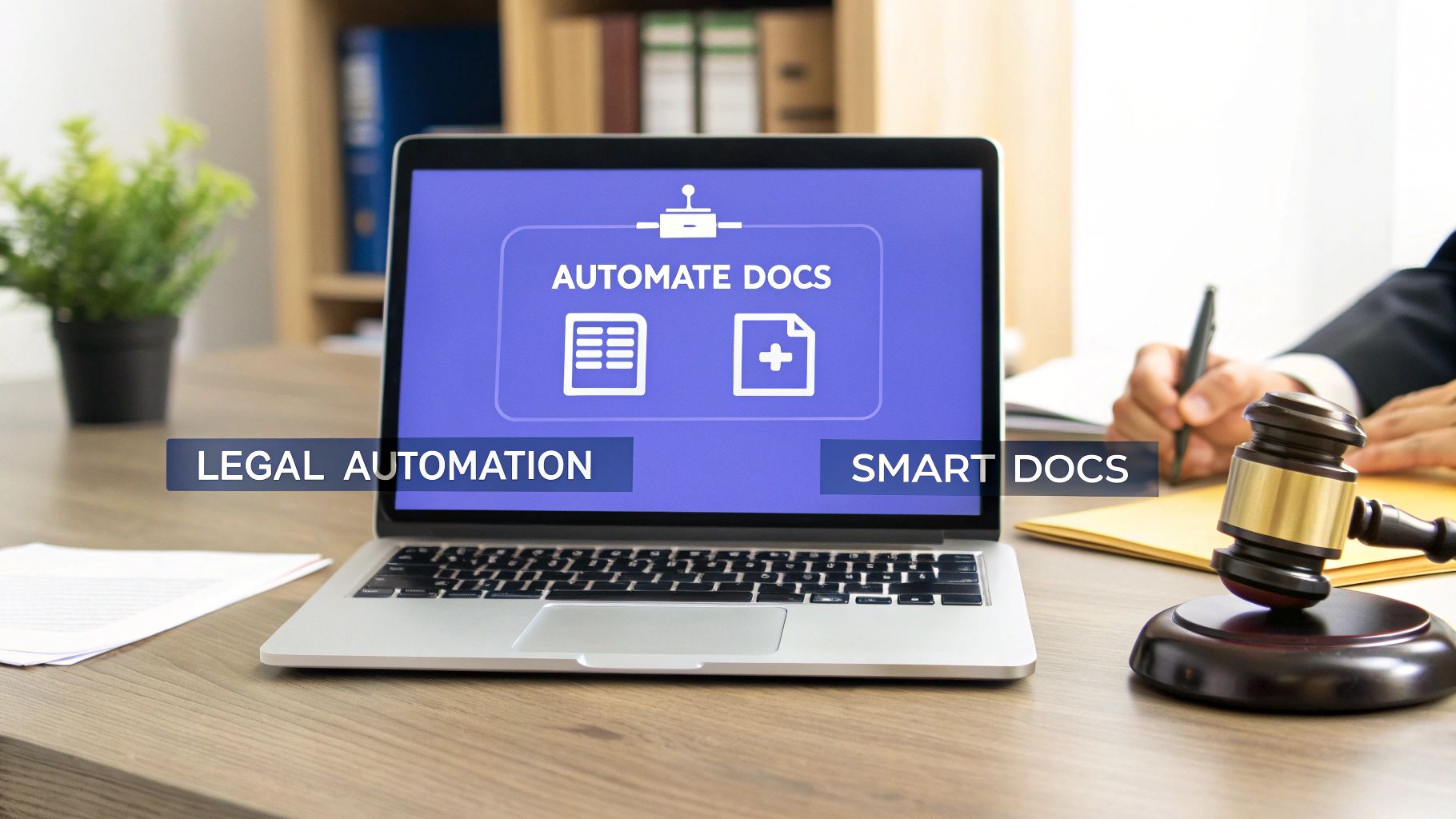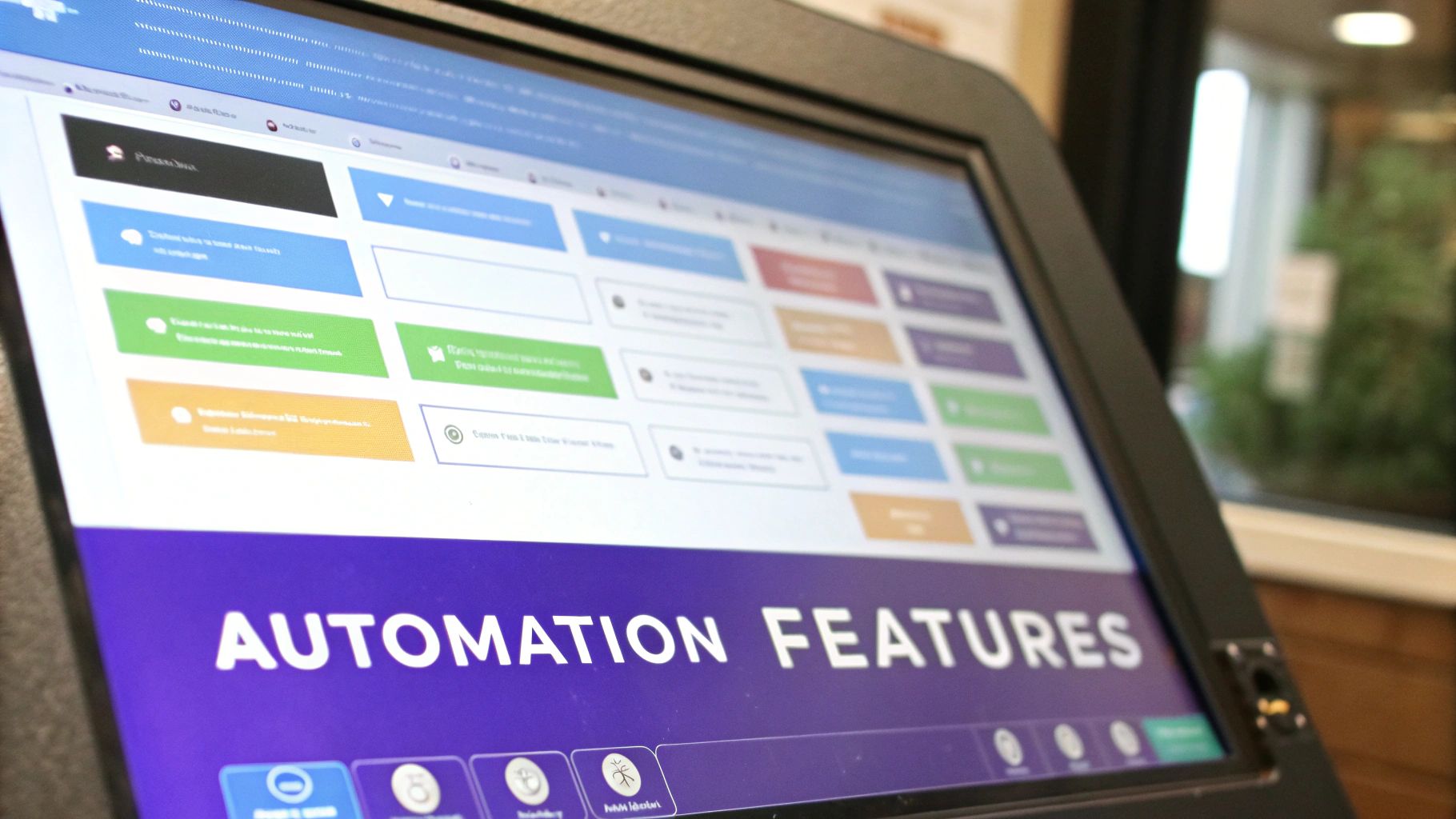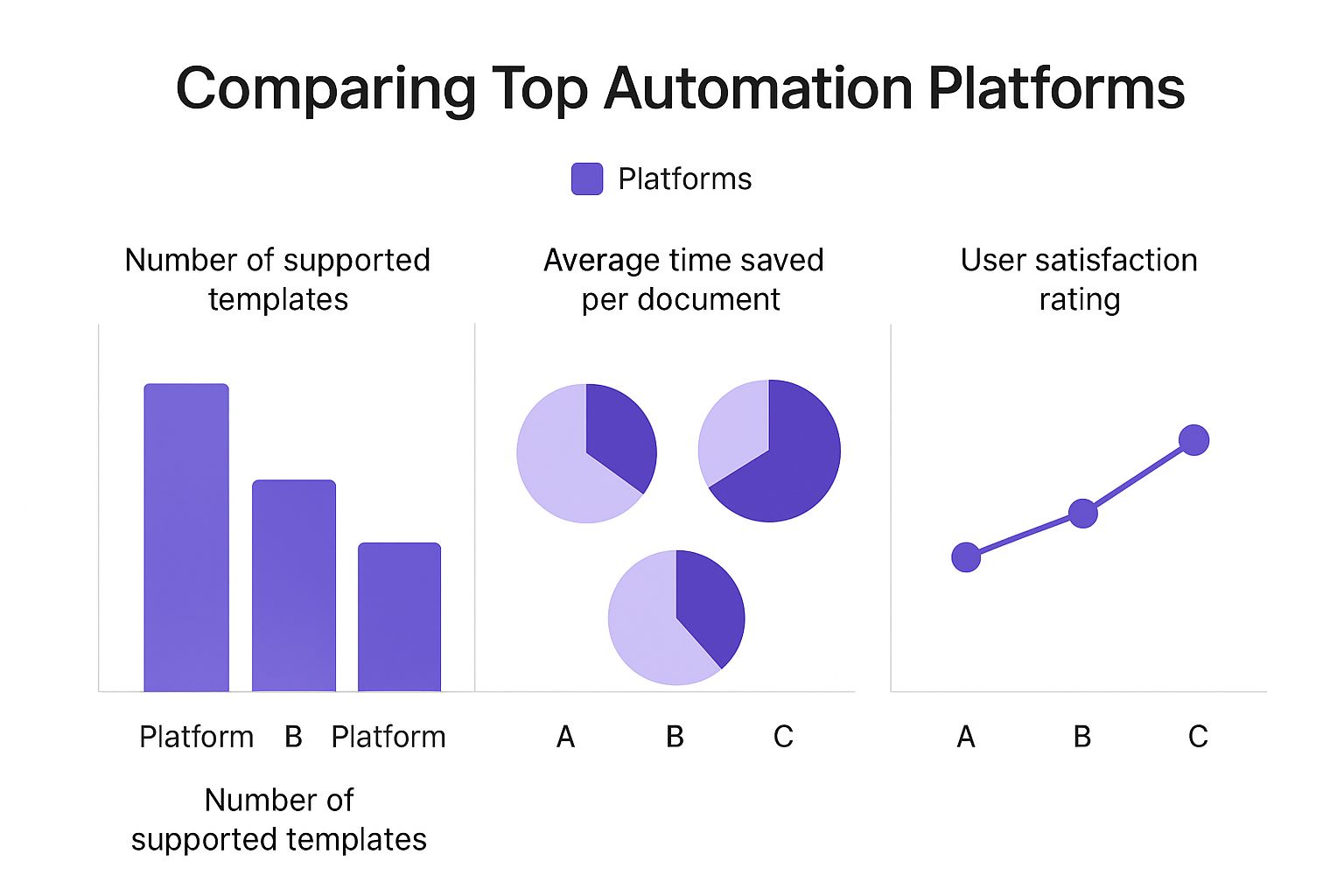
Understanding What Legal Document Automation Really Means

Legal document automation is more than simply filling out pre-existing templates. It represents a significant shift in how legal professionals work, allowing them to transition from time-consuming manual tasks to more efficient, automated processes. This change allows lawyers to dedicate more time to valuable activities such as client interaction and strategic planning, instead of spending hours on repetitive drafting work. The result is faster turnaround times for clients and increased profitability for law firms.
Beyond Basic Templates
While templates provide a useful starting point, true legal document automation goes much further. It involves using software with conditional logic, enabling documents to change based on specific client details.
For example, a contract template could automatically modify clauses based on the client's state of residence or business type. This eliminates the need for manual revisions and minimizes the risk of errors.
Furthermore, advanced automation platforms frequently integrate with other legal software like Clio or MyCase, streamlining workflows and data management. This creates a central hub for all document-related activities, from the initial draft to the final signature.
The Power of AI in Legal Document Automation
Modern legal document automation platforms often utilize AI to boost efficiency and accuracy. AI-powered tools can analyze existing documents to identify important terms and clauses and can even suggest improved wording. This not only accelerates the drafting process but also helps ensure compliance and reduce risk.
It's essential to remember that AI is a tool to assist, not a replacement for legal expertise. Human oversight remains vital to ensure the quality and accuracy of legal documents. Attorneys retain control, reviewing and approving documents generated by the automation system.
The effects of these developments are evident in the market's growth. Robotic Process Automation (RPA) in legal services, including document automation, is expected to grow substantially. The market size is predicted to increase from approximately USD 3.15 billion in 2025 to around USD 13.09 billion by 2034, exhibiting a CAGR of roughly 17.14%. This expansion underscores the growing recognition of automation's benefits within the legal field. Explore this topic further. Firms that embrace these technologies are poised to gain a considerable competitive advantage. They can deliver faster service, reduce expenses, and ultimately, provide more value to their clients.
Why Smart Firms Are Racing To Automate Now
The legal industry is experiencing a significant shift, with legal document automation leading the charge. This isn't simply a passing trend; it represents a fundamental change in how legal work gets done. Forward-thinking firms are embracing automation to gain a substantial competitive advantage. But what's driving this rapid adoption of automated tools?
The Demand for Efficiency and Accuracy
A key driver is the growing need for both efficiency and accuracy in legal tasks. Clients now expect faster turnaround times and error-free documents. Automation provides the tools to meet these demands. By automating repetitive processes like drafting standard contracts or creating compliance reports, firms greatly reduce time spent on manual work. This allows lawyers to dedicate their time to more valuable tasks, such as client counseling and strategic planning.
Moreover, automation minimizes the potential for human error, resulting in more precise and consistent documents.
Market Growth Reflects Increasing Demand
This rising demand is apparent in the expansion of the legal document automation software market. Valued at roughly USD 1.13 billion in 2025, the market is projected to reach approximately USD 3 billion by 2033. This represents a compound annual growth rate (CAGR) of about 13%. The need for improved processes and flawless documentation across diverse industries is fueling this growth. Find more detailed statistics here.
To further illustrate the regional impact of this growth, the following table provides a breakdown:
Legal Document Automation Market Growth by Region
| Region | Current Market Share | Projected Growth Rate | Key Drivers |
|---|---|---|---|
| North America | 45% | 12% | High adoption of cloud-based solutions, strong focus on efficiency |
| Europe | 30% | 14% | Increasing regulatory complexity, demand for cost-effective legal services |
| Asia Pacific | 15% | 18% | Rapid digitalization, rising legal spending |
| Rest of the World | 10% | 10% | Growing awareness of automation benefits, increasing investment in legal tech |
This table showcases the varied growth rates and market share across different regions, highlighting the global impact of legal document automation. The higher growth projections in Europe and Asia Pacific indicate significant potential in these markets.
The Competitive Landscape
The evolving competitive landscape is another factor pushing firms toward automation. Firms that adopt automation can manage greater workloads with increased speed and accuracy. This allows them to serve a larger client base and potentially explore new markets. This improved efficiency also translates to cost savings, boosting their competitiveness on pricing.
Staying Ahead of the Curve
Finally, astute firms understand that automation isn't just about meeting present needs. It's about preparing for the future of legal practice. As client expectations shift and technology advances, the ability to effectively use automation will become essential for maintaining a competitive edge. Firms that invest in automation now are securing their long-term success and building a foundation for ongoing growth in an increasingly competitive field.
The Real Benefits Beyond The Sales Pitch

What real improvements can attorneys expect from legal document automation? It's more than just saving time; it's about the positive changes seen by lawyers in their everyday practice.
Measurable Improvements in Efficiency and Accuracy
One immediate advantage is a significant decrease in document turnaround time. Tasks that once took hours can now be finished in minutes.
For example, creating a standard contract, previously involving drafting and revisions, can be done almost instantly with automation. This speed boost lets firms handle more work and respond faster to clients.
Automation also improves accuracy. By reducing manual data entry and repetitive work, human error is minimized. This results in dependable and consistent documents, building client trust and lowering the risk of mistakes.
Firms can then offer a more reliable and efficient service, leading to greater client satisfaction and better relationships. For a deeper dive into this, check out this guide on legal document review services.
Impact on Different Practice Areas
The benefits of legal document automation reach across different legal specialties. While areas like transactional law might adopt it faster, the improvements are just as valuable in litigation or estate planning.
In litigation, automation streamlines creating pleadings and discovery documents. In estate planning, it simplifies preparing wills and trusts. This versatility makes it useful for any firm wanting better efficiency and accuracy.
From Efficiency Gains to Revenue Growth
Time saved is valuable, but the real benefit is how that translates into financial gains. By freeing lawyers from routine tasks, automation allows them to focus on billable work.
This shift can boost revenue, especially for firms that bill hourly. The advantages extend beyond just increasing billable hours; they also enhance client relationships.
Client Satisfaction and Long-Term Commitment
Automation contributes to improved client relationships. Quicker turnaround times and greater accuracy show dedication to efficient and reliable service.
This higher client satisfaction can lead to lasting client loyalty and positive referrals. This ultimately contributes to firm growth and profitability.
The combined effect of these benefits makes legal document automation a vital investment for today's law firms. Learn more about streamlining legal processes in this helpful resource: How to master....
Cloud Versus On-Premise: Making The Smart Choice
Choosing between cloud-based and on-premise solutions for legal document automation is a crucial decision. It significantly impacts a firm's efficiency and ability to grow. Both options automate document creation, but they differ in setup, upkeep, and long-term costs. Practical considerations should guide this decision, not just technical specs.
Evaluating Your Options
Many firms focus too much on technical details and not enough on what they actually need. Successful firms consider factors like practice size, client needs, and current IT setup. For example, a small firm with limited IT staff might prefer a cloud-based solution for its ease of use. A larger firm with strict security rules might choose an on-premise solution. For more information about how AI influences these choices, see our guide on AI for legal documents.
Long-term effects are also important. Cloud solutions are flexible and scalable, helping firms adapt to change. On-premise solutions offer more control over data and customization. The growing legal document automation market highlights the importance of these decisions. The market was valued at about USD 2 billion in 2025. It’s expected to hit USD 6 billion by 2033, a 15% CAGR. The rising use of cloud-based platforms is notable because they can adapt and serve different clients, from small businesses to large corporations. Discover more insights about this growth.
Case Studies and Key Insights
Real-world examples show the differences between cloud and on-premise solutions. Some firms that chose cloud solutions liked the lower upfront costs and quick setup. This allowed them to benefit from automation right away. Other firms that went with on-premise solutions preferred the control over data and customization options.
To help illustrate the key differences between cloud-based and on-premise solutions, let's look at the following comparison table:
Cloud vs On-Premise Legal Automation Solutions Comparison: Detailed comparison of features, costs, and benefits between cloud and on-premise legal document automation platforms.
| Feature | Cloud-Based | On-Premise | Best For |
|---|---|---|---|
| Implementation | Quick and easy | Complex and time-consuming | Firms wanting rapid deployment |
| Cost | Lower upfront cost, subscription-based | Higher upfront cost, ongoing maintenance | Budget-conscious firms vs. firms with large upfront capital |
| Maintenance | Managed by provider | Requires dedicated IT staff | Firms with limited IT resources vs. firms with extensive IT capabilities |
| Security | Dependent on provider’s security measures | Full control over security | Firms prioritizing ease of use vs. firms with high security needs |
| Scalability | Highly scalable | Limited scalability | Growing firms vs. firms with stable size |
| Customization | Limited customization options | Extensive customization options | Firms needing standard features vs. firms needing specialized features |
| Data Control | Data stored on provider’s servers | Full control over data | Firms comfortable with external data storage vs. firms requiring maximum data control |
Key takeaway: Cloud solutions are generally better for smaller firms needing quick, affordable automation. On-premise solutions are better for larger firms prioritizing control and customization.
The following infographic visualizes key data comparing three top legal document automation platforms:

As shown, Platform B has the most templates and saves the most time. Platform C has the highest user satisfaction. These details are important for making good decisions.
The best choice depends on each firm's needs. There is no single right answer. Understanding your needs is the first step in making the best decision.
Implementation That Actually Sticks

Successfully integrating new technology into a law firm can be a real challenge. Implementations frequently fall short. But by understanding why these projects fail, we can chart a course to success with legal document automation. This isn't about abstract ideals; it's a practical guide based on proven methods.
Identifying the Right Starting Point
The key is to pinpoint the areas where automation will deliver the greatest impact. Avoid the temptation to automate everything at once. Begin with frequently used document types that are susceptible to errors. This targeted strategy allows for quick, demonstrable wins, building momentum for broader adoption.
For example, automating NDAs or basic contracts is a good starting point before tackling complex litigation documents. This gives your team a chance to acclimate to the technology and experience its advantages. Also, consider your firm’s current tech setup. Choosing a system that integrates with existing software minimizes disruption. For more on this, see: How to master contract management.
Managing Team Resistance
Change is often met with resistance. Anticipate and address this by involving your team from the outset. Clearly explain the advantages of legal document automation, emphasizing how it streamlines their work, not eliminates it. Thorough training is essential to build confidence and address any apprehension.
This could include hands-on workshops, user-friendly guides, and continuous support. Investing in training fosters a positive attitude towards the new system and reduces frustration in the long term.
Measuring Progress That Matters
To show the true value of automation, track the right metrics. Focus on concrete results like faster document turnaround times, fewer errors, and increased client satisfaction. These quantifiable improvements prove the system's effectiveness and justify continued investment.
Furthermore, measuring progress is an ongoing process. Regularly evaluate the system’s performance and look for areas to improve. This consistent monitoring keeps your legal document automation effective and adaptable to your firm’s changing requirements. It also provides data-backed insights to refine strategies and maximize the benefits of automation.
Scaling Automation Effectively
After achieving initial success, strategically expand automation to other practice areas. A gradual rollout lets you maintain quality while maximizing the benefits of the technology, ensuring its continued effectiveness as you broaden its application.
Continuously gather client feedback and incorporate it into your automated workflows. This client-focused approach ensures that automation improves, rather than hinders, the quality of your service. By following these practical steps, your firm can effectively implement legal document automation for long-term success, translating to time savings and tangible financial growth.
Preparing For What's Coming Next
Legal document automation is a constantly changing field. Staying informed about these changes helps your firm remain adaptable and successful. This proactive approach allows for strategic decision-making that benefits your practice over time.
Emerging Technologies Reshaping Automation
Developments like advanced natural language processing (NLP) and machine learning integration are poised to significantly change legal document automation. Advanced NLP allows software to better understand and interpret legal language. This means automation can handle more complex documents and tasks. Machine learning builds upon this by allowing the system to learn from data, improving performance over time.
Imagine an automation platform that analyzes a contract, identifies potential risks, and even suggests alternative clauses. This advanced automation can substantially improve the efficiency and accuracy of legal work.
Client Expectations and Competitive Pressures
Evolving client expectations are also pushing innovation in legal document automation. Clients now expect quick turnaround times and clear communication. Automation helps firms meet these demands by streamlining processes and increasing efficiency. Furthermore, competition within the legal field encourages firms to adopt automation to lower costs and stay competitive. This includes exploring tools like document processors and implementing efficient contract management systems.
Positioning Your Practice for Continued Success
To prepare for the future of legal document automation, firms should concentrate on building important skills. This includes training staff to effectively use automation platforms and integrating these tools into existing workflows. It's about maximizing the benefits of technology within your firm, not just adopting the latest tools. A commitment to ongoing learning is also key to understanding the changing world of legal document automation. Staying informed about new developments helps your firm adapt strategically and capitalize on new opportunities.
The Impact of Today's Decisions
The automation choices you make today will significantly affect your firm's future competitiveness. Investing in the right tools and strategies now sets your firm up for success and prepares you for the constantly changing legal landscape. A proactive approach to legal document automation allows your firm to improve efficiency, boost client satisfaction, and stay competitive. These decisions are not just about immediate benefits; they are about building a sustainable model for long-term success.
Your Practical Next Steps
Transitioning to legal document automation requires a structured approach. This practical guide provides actionable steps to evaluate your current processes, identify automation opportunities, and build a compelling business case for adopting this technology.
Evaluating Your Current Document Processes
Begin by analyzing your current document workflows. Identify bottlenecks, repetitive tasks, and common errors. This evaluation clarifies where automation can deliver the greatest impact.
- Document Inventory: List all document types used by your firm.
- Frequency Analysis: Track how often each document type is created.
- Time Audit: Measure the time spent drafting, reviewing, and finalizing each document.
- Error Analysis: Identify common errors and their associated costs.
This initial assessment reveals which documents are best suited for automation. Focusing on high-volume, error-prone documents maximizes your return on investment.
Identifying Opportunities and Building Your Business Case
Once you understand your current processes, pinpoint specific opportunities where legal document automation can boost efficiency and accuracy. Quantify the potential benefits to build a strong business case.
- Time Savings: Calculate the potential time saved by automating document creation.
- Error Reduction: Estimate the cost savings from minimizing errors.
- Increased Capacity: Project how much additional work can be handled with automation.
- Improved Client Satisfaction: Explain how faster turnaround times and accurate documents improve client experiences.
These quantifiable benefits offer concrete justification for investing in legal document automation technology.
Assessing Vendors and Implementing Pilot Programs
The next step involves carefully assessing vendors based on your firm's specific needs and budget. A pilot program is a valuable way to test a legal document automation system before full implementation.
- Vendor Selection: Evaluate vendors based on features, pricing, and integrations.
- Pilot Program Design: Choose a small group of users and a specific set of documents for your pilot.
- Success Metrics: Define clear metrics to measure the pilot program's success.
For example, track time savings, error reduction, and user feedback during the pilot. These measurable results provide valuable insights into the chosen system’s effectiveness.
Scaling and Optimizing Your Automation Strategy
After a successful pilot program, strategically expand your automation efforts. Begin with a gradual rollout to more users and document types. Continuously monitor performance and refine workflows as you scale.
- Phased Rollout: Gradually implement the automation system across your firm.
- Ongoing Training: Provide continuous training and support for all users.
- Performance Monitoring: Track key metrics to assess the automation’s effectiveness.
- Continuous Optimization: Identify ways to further improve workflows and boost efficiency.
This iterative process helps refine your legal document automation strategy and ensures ongoing success as your firm expands. By following these practical steps, you can seamlessly integrate automation and benefit your practice now and in the future.
Ready to simplify your legal document processes and unlock new efficiencies? Visit Legal Document Simplifier to explore how their AI-powered platform can transform your workflow.